Introduction
In recent decades, remarkable advancements have been made in extending the boundaries of nuclear stability, leading to the discovery of numerous dripline nuclides. These nuclides, which are characterized by a significant imbalance in their proton–neutron ratios, exhibit exotic modes of radioactivity and are significantly influenced by the continuum effect. Notably, two-proton (2p) emission, initially proposed by Goldansky in the early 1960s [1, 2], has only been observed in recent years [3, 4], making it a particularly rare form of radioactivity. This decay process is essentially a three-body quantum-tunneling phenomenon occurring in extremely proton-rich nuclei. It indicates the complex interplay between the daughter nucleus and valence protons [5-9]. The decay mechanisms vary across different 2p emitters [10-14], encompassing diproton decay and large-angle emission [15-18], depending on the internal structure of the nuclei and the properties of adjacent nuclei [19-23]. This diversity in decay processes and the potential to investigate them via proton emission correlation measurements have garnered significant interest and serve as crucial testing grounds for both nuclear physics and quantum theory.
Investigations beyond the proton dripline have revealed nuclei that are unbound with respect to new decay channels, including multi-proton emitters. This highlights the significance of such exotic decay modes as the precursor decay energy increases. Notable examples include nuclei that emit three protons (3p), such as 7B [24], 17Na [25], 31K [26], and 13F [27], as well as ground-state emitters of four protons (4p), like 8C [28] and 18Mg [29], and a five-proton (5p) emitter, 9N [30]. Although the decay characteristics of many of these systems have not been investigated, analyses show that their decay may proceed in multiple steps, shedding excess protons through sequential 1p or 2p emission. 18Mg, which has been recently discovered [29], decays via sequential 2p-2p emission of two pp pairs. Therefore, studies investigating whether the first-step 2p decay of 18Mg resembles that of other 2p emitters and how the inner structure impacts this process are required.
Addressing the complexities of these phenomena requires sophisticated theoretical frameworks; however, comprehensive models that can simultaneously address the nuances of 2p and multi-proton emissions are still under development. Various approaches [31-34] have been employed, including the configuration interaction and density functional methods for structure analysis [35-40], and few-body methods for probing asymptotic proton correlations [41-45]. Innovations such as the shell model embedded in the continuum and the Gamow shell model integrate continuum effects into the configuration interaction framework, whereas hybrid methods leverage spectroscopic factors and few-body partial decay widths. Although the spectra and isospin-symmetry breaking between 18Mg and mirror symmetry 18C have been extensively investigated [46-49], the properties of the 18Mg-18C pair, especially the structures and time-dependent nucleon–nucleon correlations, have not yet been elucidated. This study employed the Gamow coupled-channel (GCC) method, a three-body approach that incorporates continuum effects, to investigate the decay dynamics and asymptotic correlations of 2p emitters, with a particular focus on the first-step 2p emission of 18Mg and the configurations of its valence protons.
The remainder of this paper is organized as follows. Section 2 describes the models and Hamiltonian. In particular, it presents the framework of the GCC method and time-dependent approach. The structural and decay properties of 18Mg are discussed in Sect. 3. Finally, the summary is presented in Sect. 4.
Theoretical Model
Gamow coupled-channel approach(GCC)
In this study, we used a GCC approach [50, 51], which is a three-body model describing 18Mg in terms of two valence protons and a core (16Ne). To describe the three-body asymptotic behavior, the coordinates of 18Mg can be expressed in Jacobi (relative) coordinates:
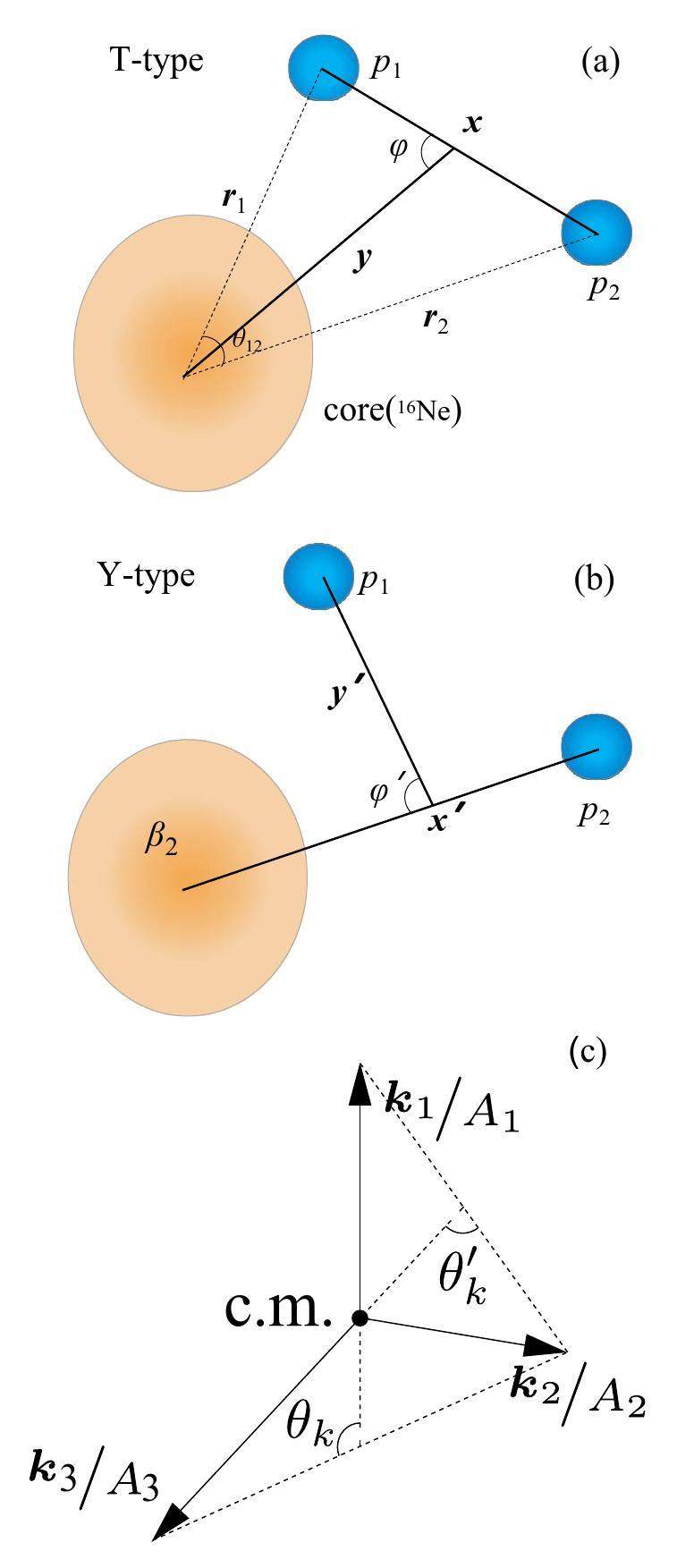
As the experimental measurements are performed in the momentum space, the relative momentum is defined as follows:
The total wave function in the Jacobi coordinates of the mother nucleus, which couples with the p–p pair and 16Ne, can be expressed as
The 16Ne + p + p Hamiltonian of GCC can be expressed as
To address the antisymmetrization between core and valence protons, a supersymmetric transformation method [58-60] was employed. This method introduces an auxiliary repulsive “Pauli core” in the original core-p interaction to eliminate Pauli-forbidden states.
Consequently, the acquired eigenstate possesses a complex energy denoted by
Hamiltonian and parameters
Magnesium isotopes often exhibit significant deformation. However, due to the lack of definitive experimental data on their deformation, the deformation factor is adopted from their mirror nucleus, 18C, which exhibits a quadrupole deformation, β2, of approximately 0.3, as reported in [63]. The ground and 2+ states of the deformed core were considered through non-adiabatic coupling with the valence nucleons, and the corresponding energies were obtained from experimental data [63]. A previous study [38] reported significant mirror symmetry breaking in the 16Ne-16C mirror pair due to different configurations [64, 65]. However, the excitation energies of their first 2+ states are remarkably similar, with 16Ne at 1.77(0) MeV and 16C at 1.76(6) MeV. Consequently, the breaking of mirror symmetry within the current framework cannot easily be described.
In a three-body system (16Ne + p + p), the interaction between the two protons is described by the finite-range Minnesota force, adhering to the original parameters specified in Ref. [66]. This interaction is further supplemented by a two-body Coulomb force applied to protons. The core-proton (core-p) effective interaction was modeled using a WS potential (with a spin–orbit term) and one-body Coulomb interaction. The parameters of the WS potential, except for the potential depth V0 and– the spin–orbit strength Vs.o., were retained as default values, as detailed in Ref. [67]. The spin–orbit strength was set to 24 MeV. Additionally, the depth V0 was finely adjusted to accurately replicate the experimental ground state decay energy,
The three-body configurations in Jacobi coordinates are labeled by quantum numbers
Results and Discussions
Structure information of 18Mg and 18C
A highly proton-rich nucleus, 18Mg, located far from the β-stability line, has been recently identified as a 4p emitter [29]. The 4p decay proceeds through a two-step 2p decay via the intermediate ground state of 16Ne. To elucidate the internal structure of 18Mg and its influence on decay properties, we begin by examining the spectrum and valence-proton configurations of 18Mg and comparing them with its mirror partner, 18C. The mirror pair, due to isospin symmetry, typically exhibits similar properties across many aspects. However, Coulomb interactions introduce discrepancies in their thresholds. Consequently, 18Mg is particle-unbound, with a 2p separation energy of S2p(18Mg) = -3.44 MeV, whereas 18C is bound to a 2n separation energy of S2n(18C) = 4.92 MeV, as determined experimentally.
The calculated spectra of 18Mg and 18C align qualitatively, if not quantitatively, with the experimental data (Fig. 2). Specifically, the excitation energy of the first 2+ state is slightly underestimated for 18Mg. Meanwhile, although only one 2+ state is observed experimentally, our calculation predicts two low-lying 2+ states, similar to the situation in its mirror system 18C. The ground state of 18Mg is less unbound than those of 17Na and 16Ne. Considering the large decay width of 17Na, the ground state of 18Mg might have a “democratic” decay mode, which exhibits open 1p and 2p decay channels. This suggests potential competition between 1p and 2p decay modes during the decay process of 18Mg. To determine the primary decay mechanism, we used a time-dependent approach to analyze the corresponding decay dynamics (see the discussion below).
However, due to the Coulomb interaction, 18Mg is less bound than its mirror partner, indicating a greater continuum effect. As presented in Table 1, the sd-shell effect significantly influences the ground-state configuration of valence neutrons in 18C, favoring the configurations (K,
| 18Mg | 18C | |
|---|---|---|
| 34.86% (4,0,0,0) | 39.68% (4,0,0,0) | |
| 19.36% (4,1,1,1) | 25.82% (4,1,1,1) | |
| 18.00% (0,0,0,0) | 6.83% (4,0,2,0) | |
| 13.36% (4,0,2,0) | 17.28% (4,1,1,1) | |
| 11.61% (2,0,2,0) | 14.10% (4,0,0,0) | |
| 8.29% (4,0,0,0) | 13.59% (4,0,2,0) | |
| 25.51% (4,2,2,0) | 25.57% (4,1,1,1) | |
| 16.41% (4,1,1,1) | 13.67% (4,2,2,0) | |
| 4.39% (8,4,4,0) | 11.06% (4,0,0,0) | |
| 23.39% (4,0,0,0) | ||
| 15.51% (4,1,1,1) | ||
| 9.15% (2,0,2,0) | ||
Regarding the 2+ states, although the pure s-wave component is forbidden by the angular momentum selection rule, the influence of the continuum is still noticeable, causing the configuration (K,
The internal structures of 18C and 18Mg also exhibit moderate mirror symmetry breaking, which is similar to that of the 16C-16Ne mirror pair. As illustrated by the density distributions of the valence nucleons shown in Fig. 3, the ground state of 18Mg exhibits a more expansive distribution than that of 18C, although both nuclei possess di-nucleon, cigar-like structures, and a small triangular component internally. This discrepancy is due to the significant s-wave component and unbound nature of 18Mg. Meanwhile, the internal structures of the
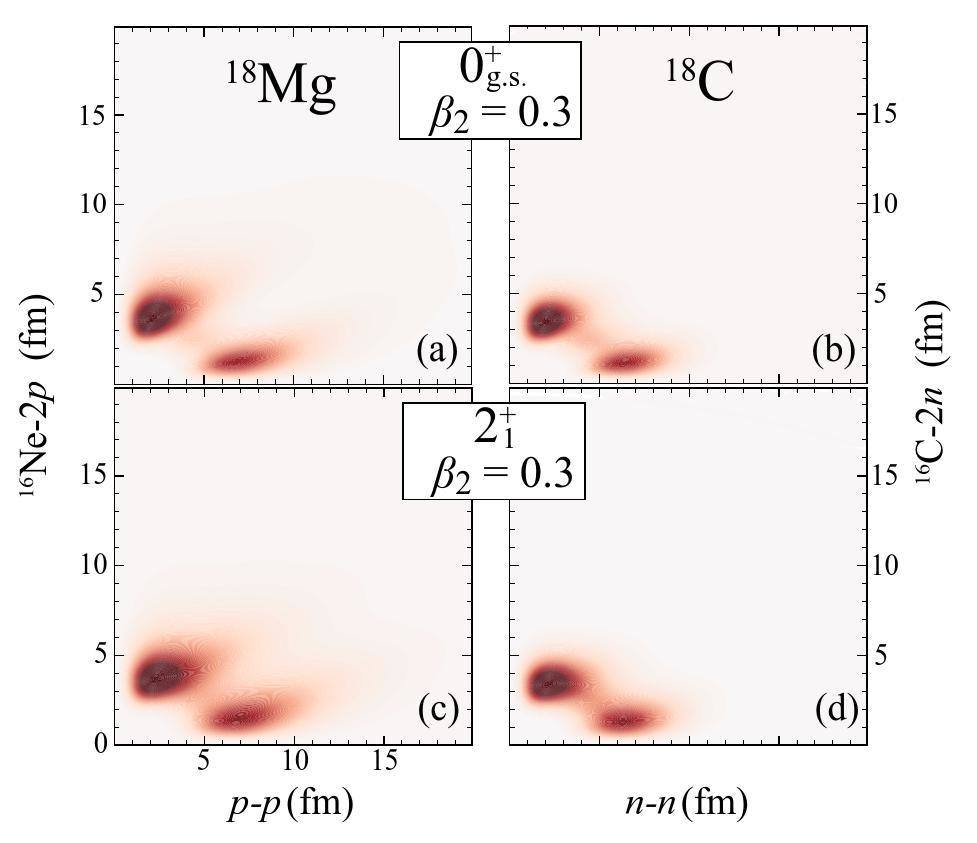
The properties of the related nucleus, 17Na, have also attracted considerable attention due to limited experimental data availability. Energy spectra have been calculated in several studies to predict the decay scheme of 17Na [71, 72]. In addition, to assess the effect of deformation on structural characteristics and decay properties, we computed the energy spectrum of 17Na and the 2p density distributions of the 18Mg ground state as functions of the quadrupole deformation parameter β2 (refer to Figs. 4 and 5). The analysis of the spectral evolution of 17Na reveals a gap between the s and d orbitals with increasing deformation. This gap is also observed as the (K,

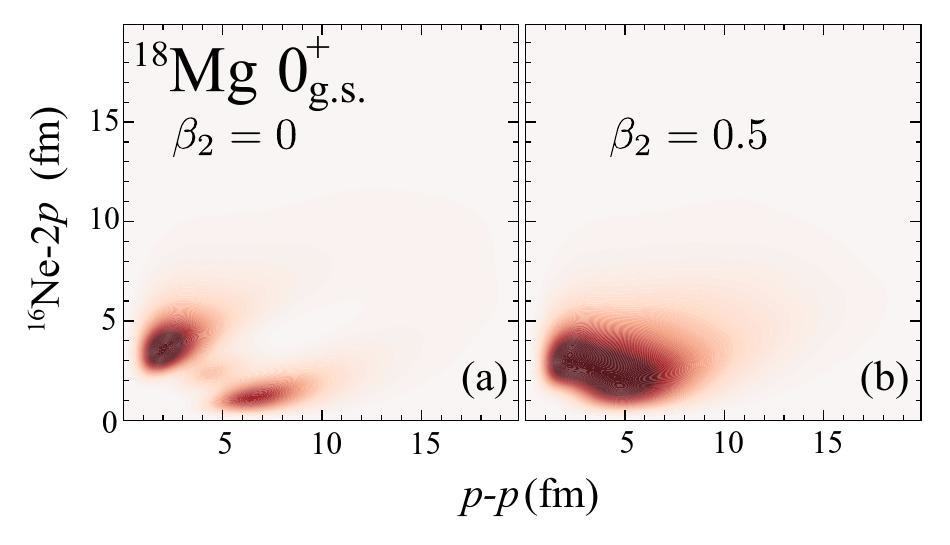
Decay properties of 18Mg
The internal configurations and spectroscopic details of 18Mg and its adjacent nuclei have been reported previously. An intriguing aspect to further examine is the influence of these properties on the decay dynamics and mechanisms. For this purpose, we employed a time-dependent framework to evolve the initial wave function across extensive spatial and temporal scales, as shown in Fig. 6.
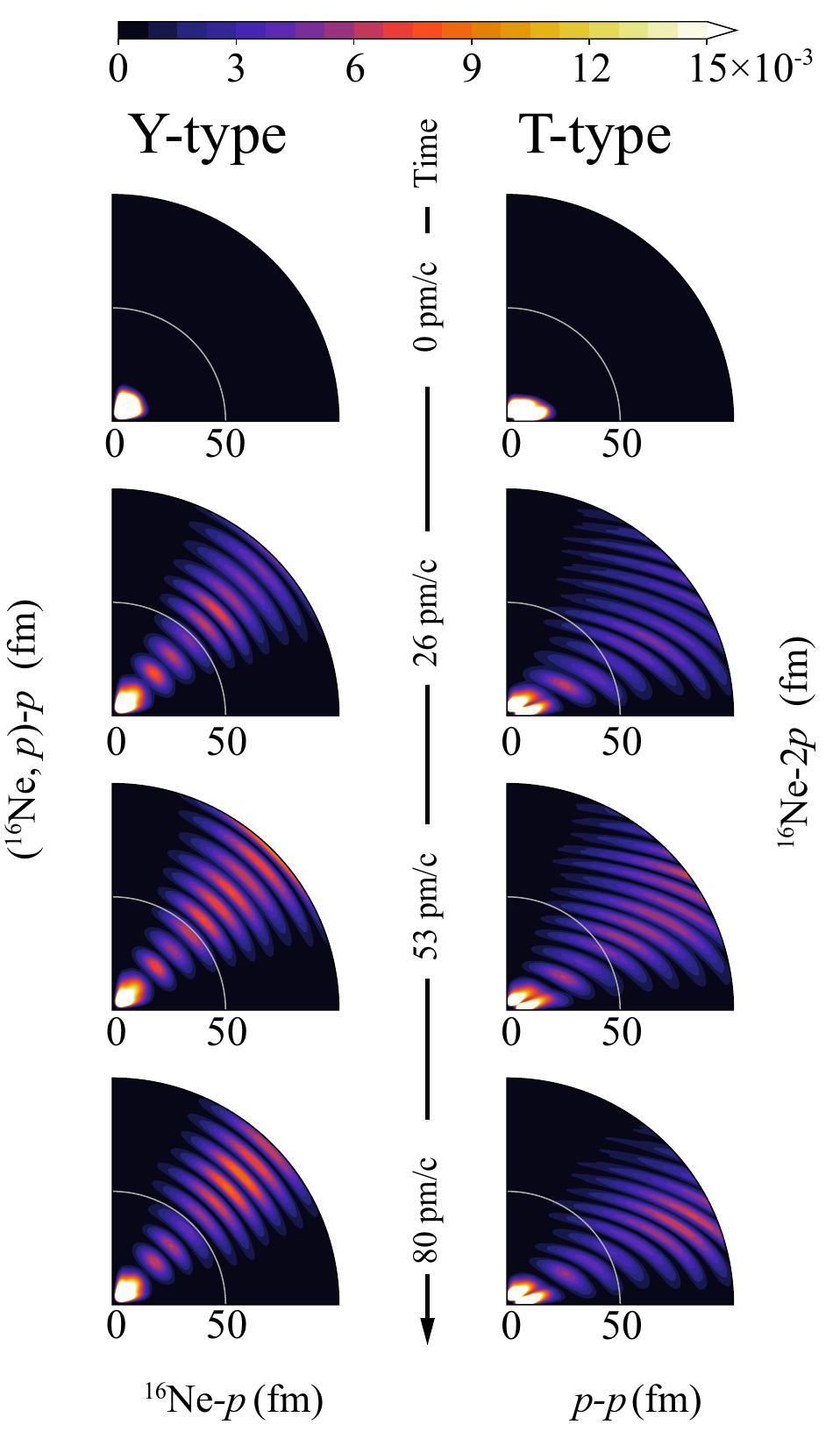
Initially (t = 0), most of the 18Mg ground-state wave function was confined within the nuclear boundary, forming the discussed diproton and cigar-like structures. However, the density evolution within the Jacobi-T coordinate reveals the merging of these structures during the tunneling phase; a dynamic distinct from the decay behavior observed in the p-shell nucleus 6Be [61] but similar to that of the sd-shell nucleus 12O [73]. This similarity is attributed to the substantial s-wave component and relatively large decay energy/width characteristic of the 18Mg ground state. Concurrently, in the decay process, the distance between 16Ne and a proton remains similar to the increasing separation in the (16Ne,p)–p configuration, as observed in the density evolution depicted in the Jacobi-Y coordinate shown in Fig. 6. This observation suggests that, despite the energetic feasibility of single-proton decay for the 18Mg ground state, simultaneous two-proton emission is the most probable decay mode.
The correlations between protons emitted from the ground state of 18Mg are shown in Fig. 7. Given the notably wide decay widths associated with light–mass systems, the energy or angular distributions cannot easily reveal distinct patterns that could differentiate between decay mechanisms. Specifically, for 18Mg, the energy correlation of the T-type is almost uniform, which is attributed to the substantial s-wave component within the ground-state wave function, as previously discussed. Meanwhile, the Y-type energy correlation attains a noticeable peak around

Furthermore, we investigated the effect of deformation on the asymptotic correlations of 18Mg, as shown in Figs. 7 and 8. When the quadrupole deformation β2 changes from 0 to 0.3, the asymptotic correlation is slightly affected. However, the T-type energy correlation and Y-type angular correlation are significantly changed for β2 = 0.5. This is in accordance with the change in the internal structure/configuration as deformation increases. In particular, enhanced peaks are observed in the small Epp and largeθk regions (see Fig. 8), which might indicate a diproton emission, although the density of the valence proton inside the nucleus is uniformly distributed for β2 = 0.5 (see Fig. 5). Given that nucleon–nucleon correlation can be directly measured, further experimental investigations are required.
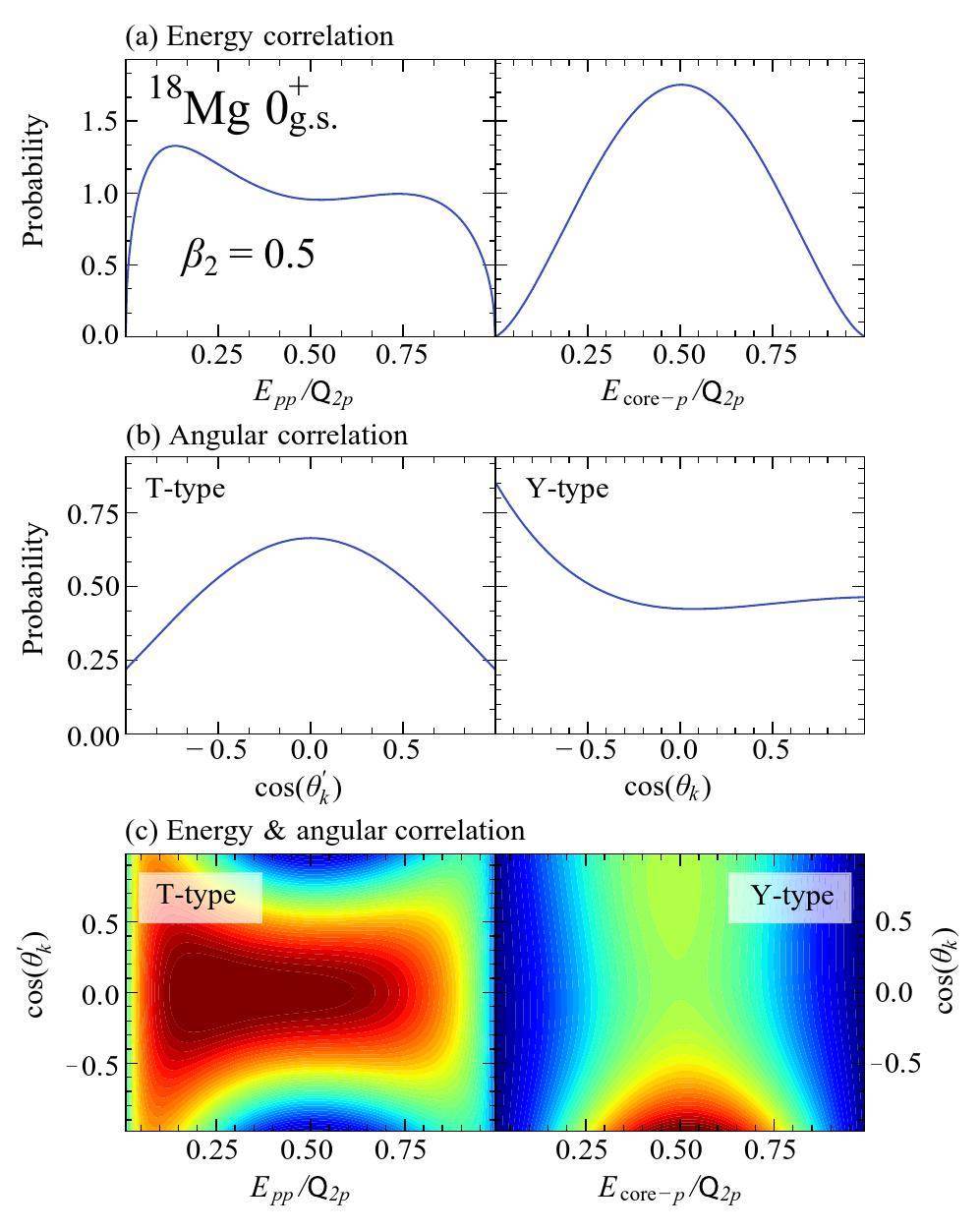
Summary
In this study, we investigated the structure and 2p decay mechanism of 18Mg using a three-body Gamow-coupled-channel model and compared it with its mirror partner, 18C. Our analysis revealed that although both systems exhibited di-nucleon and cigarlike structures in their valence nucleon configurations, moderate mirror symmetry breaking occurred in the density distributions and spectroscopy due to the Thomas–Ehrman effect. The influence of the continuum on the ground state of 18Mg induced a significant s-wave component.
The structural characteristic of 18Mg led to widespread distribution of the nucleon–nucleon correlation within the asymptotic region, similar to the behavior of other 2p emitters in the light–mass region. Furthermore, decay dynamics analysis showed that 18Mg underwent simultaneous 2p emission in the initial decay step, despite the energetically permitted 1p decay channel.
In addition, we investigated the effects of deformation on structural and decay properties. Results showed that deformation could alter the level gap and introduce the mixing of different components, consequently affecting primary structures. Therefore, further experiments are required to determine the inner structure and corresponding nucleon–nucleon correlation.
On neutron-deficient isotopes of light nuclei and the phenomena of proton and two-proton radioactivity
. Nucl. Phys. 19, 482-495 (1960). https://doi.org/10.1016/0029-5582(60)90258-32-proton radioactivity
. Nucl. Phys. 27, 648-664 (1961). https://doi.org/10.1016/0029-5582(61)90309-1Two-proton radioactivity of 45Fe
. Phys. Rev. Lett. 89, 102501 (2002). https://doi.org/10.1103/PhysRevLett.89.102501First evidence for the two-proton decay of 45Fe
. Eur. Phys. J. A 14, 279-285 (2002). https://doi.org/10.1140/epja/i2002-10033-9Two-proton radioactivity
. Rep. Prog. Phys. 71, 046301 (2008). https://doi.org/10.1088/0034-4885/71/4/046301Theoretical study of two-proton radioactivity. status, predictions, and applications
. Phys. Part. Nucl. 40, 674-714 (2009). https://doi.org/10.1134/S1063779609050049Recent progress in two-proton radioactivity
. Nucl. Sci. Tech. 33, 105 (2022). https://doi.org/10.1007/s41365-022-01091-1Two-proton emission and related phenomena
. Prog. Part. Nucl. Phys. 123, 104050 (2023). https://doi.org/10.1016/j.ppnp.2023.104050Research on two-proton radioactivity in density-dependent cluster model
. Sci. China-Phys. Mech. Astron. 66, 222012 (2023). https://doi.org/10.1007/s11433-022-1994-8Relation between pairing correlations and two-particle space correlations
. Phys. Rev. C 29, 1091-1094 (1984). https://doi.org/10.1103/PhysRevC.29.1091Generic strong coupling behavior of Cooper pairs on the surface of superfluid nuclei
. Phys. Rev. C 76, 024310 (2007). https://doi.org/10.1103/PhysRevC.76.024310Pairing correlations in nuclei on the neutron-drip line
. Phys. Rev. C 72, 044321 (2005). https://doi.org/10.1103/PhysRevC.72.044321Coexistence of BCS- and BEC-like pair structures in halo nuclei
. Phys. Rev. Lett. 99, 022506 (2007). https://doi.org/10.1103/PhysRevLett.99.022506Properties of proton-rich nuclei in a three-body model
. Eur. Phys. J. A 37, 361-366 (2008). https://doi.org/10.1140/epja/i2008-10626-2Complete correlation studies of two-proton decays: 6Be and 45Fe
. Phys. Lett. B 677, 30-35 (2009). https://doi.org/10.1016/j.physletb.2009.04.085Experimental study of two-proton correlated emission from 29S excited states
. Phys. Rev. C 80, 014310 (2009). https://doi.org/10.1103/PhysRevC.80.014310Experimental study of the two-proton correlated emission from the excited states of 17,18Ne and 28,29S
. Nucl. Phys. A 834, 450c-453c (2010), the 10th International Conference on Nucleus-Nucleus Collisions (NN2009). https://doi.org/10.1016/j.nuclphysa.2010.01.061Correlated two-neutron emission in the decay of the unbound nucleus 26O
. Phys. Rev. C 89, 014331 (2014). https://doi.org/10.1103/PhysRevC.89.014331Observation and spectroscopy of new proton-unbound isotopes 30Ar and 29Cl: An interplay of prompt two-proton and sequential decay
. Phys. Rev. Lett. 115, 202501 (2015). https://doi.org/10.1103/PhysRevLett.115.202501Different mechanism of two-proton emission from proton-rich nuclei 23Al and 22Mg
. Phys. Lett. B 743, 306-309 (2015). https://doi.org/10.1016/j.physletb.2015.02.066Continuum effects in neutron-drip-line oxygen isotopes
. Phys. Rev. C 96, 024308 (2017). https://doi.org/10.1103/PhysRevC.96.024308Opening angle and dineutron correlations in knockout reactions with borromean two-neutron halo nuclei
. Phys. Rev. C 104, 024618 (2021). https://doi.org/10.1103/PhysRevC.104.024618Isobaric multiplet mass equation for A=7 and 8
. Phys. Rev. C 84, 051308 (2011). https://doi.org/10.1103/PhysRevC.84.051308Proton-decaying states in light nuclei and the first observation of 17Na
. Phys. Rev. C 95, 044326 (2017). https://doi.org/10.1103/PhysRevC.95.044326Towards the limits of existence of nuclear structure: Observation and first spectroscopy of the isotope 31K by measuring its three-proton decay
. Phys. Rev. Lett. 123, 092502 (2019). https://doi.org/10.1103/PhysRevLett.123.092502Observation of the exotic isotope 13F located four neutrons beyond the proton drip line
. Phys. Rev. Lett. 126, 132501 (2021). https://doi.org/10.1103/PhysRevLett.126.1325012p-2p decay of 8C and isospin-allowed 2p decay of the isobaric-analog state in 8B
. Phys. Rev. C 82, 041304 (2010). https://doi.org/10.1103/PhysRevC.82.041304First observation of the four-proton unbound nucleus 18Mg
. Phys. Rev. Lett. 127, 262502 (2021). https://doi.org/10.1103/PhysRevLett.127.262502Strong evidence for 9N and the limits of existence of atomic nuclei
. Phys. Rev. Lett. 131, 172501 (2023). https://doi.org/10.1103/PhysRevLett.131.172501Cluster-orbital shell model and its application to the He isotopes
. Phys. Rev. C 38, 410-413 (1988). https://doi.org/10.1103/PhysRevC.38.410Matter densities of 8B and 8Li in a microscopic cluster model and the proton-halo problem of 8B
. Nucl. Phys. A 577, 624-640 (1994). https://doi.org/10.1016/0375-9474(94)90936-9Gamow shell model description of neutron-rich nuclei
. Phys. Rev. Lett. 89, 042502 (2002). https://doi.org/10.1103/PhysRevLett.89.042502R-matrix formulas for three-body decay widths
. Phys. Rev. C 68, 054602 (2003). https://doi.org/10.1103/PhysRevC.68.054602The R-matrix theory
. Rep. Progr. Phys. 73, 036301 (2010). https://doi.org/10.1088/0034-4885/73/3/036301Decay dynamics of the unbound 25O and 26O nuclei
. Phys. Rev. C 93, 034330 (2016). https://doi.org/10.1103/PhysRevC.93.034330Dependence of two-proton radioactivity on nuclear pairing models
. Phys. Rev. C 96, 044327 (2017). https://doi.org/10.1103/PhysRevC.96.044327Two-proton widths of 12O, 16Ne, and three-body mechanism of thomas-ehrman shift
. Phys. Rev. Lett. 88, 042502 (2002). https://doi.org/10.1103/PhysRevLett.88.042502Three-body decay of 6Be
. Phys. Rev. C 80, 034602 (2009). https://doi.org/10.1103/PhysRevC.80.034602Transition from direct to sequential two-proton decay in s–d shell nuclei
. Phys. Lett. B 762, 263-270 (2016). https://doi.org/10.1016/j.physletb.2016.09.034Complex scaled nonlocalized cluster model for 8Be
. Phys. Rev. C 105, 054317 (2022). https://doi.org/10.1103/PhysRevC.105.054317Systematic study on the proton radioactivity of spherical proton emitters
. Nucl. Sci. Tech. 34, 55 (2023). https://doi.org/10.1007/s41365-023-01201-7Two-proton radioactivity of the excited state within the gamowlike and modified gamow-like models
. Nucl. Sci. Tech. 33, 122 (2022). https://doi.org/10.1007/s41365-022-01116-9Two-proton radioactivity from excited states of proton-rich nuclei within coulomb and proximity potential model
. Nucl. Sci. Tech. 34, 130 (2023). https://doi.org/10.1007/s41365-023-01268-2Extended R-matrix description of two-proton radioactivity
. Phys. Lett. B 838, 137740 (2023). https://doi.org/10.1016/j.physletb.2023.137740Three-body spectrum of 18C and its relevance to r-process nucleosynthesis
. Few-Body Syst. 47, 213-224 (2010). https://doi.org/10.1007/s00601-010-0086-8Excited-state transition-rate measurements in 18C
. Phys. Rev. C 86, 011303 (2012). https://doi.org/10.1103/PhysRevC.86.011303One-neutron removal reactions of 18C and 19C on a proton target
. Phys. Rev. C 79, 014602 (2009). https://doi.org/10.1103/PhysRevC.79.014602Proton decays in 16Ne and 18Mg and isospin-symmetry breaking in carbon isotopes and isotones
. Phys. Rev. C 103, 044319 (2021). https://doi.org/10.1103/PhysRevC.103.044319Structure and decays of nuclear three-body systems: The Gamow coupled-channel method in Jacobi coordinates
. Phys. Rev. C 96, 044307 (2017). https://doi.org/10.1103/PhysRevC.96.044307Puzzling two-proton decay of 67Kr
. Phys. Rev. Lett. 120, 212502 (2018). https://doi.org/10.1103/PhysRevLett.120.212502Two-proton radioactivity and three-body decay. II. Exploratory studies of lifetimes and correlations
. Phys. Rev. C 68, 054005 (2003). https://doi.org/10.1103/PhysRevC.68.054005On the use of resonant states in eigenfunction expansions of scattering and reaction amplitudes
. Nucl. Phys. A 109, 265-287 (1968). https://doi.org/10.1016/0375-9474(68)90593-9A program for coupled-channel calculations with all order couplings for heavy-ion fusion reactions
. Comput. Phys. Commun. 123, 143-152 (1999). https://doi.org/10.1016/S0010-4655(99)00243-XRole of dynamical particle-vibration coupling in reconciliation of the d3/2 puzzle for spherical proton emitters
. Phys. Rev. C 64, 041304 (2001). https://doi.org/10.1103/PhysRevC.64.041304Theoretical description of deformed proton emitters: Nonadiabatic coupled-channel method
. Phys. Rev. C 62, 054315 (2000). https://doi.org/10.1103/PhysRevC.62.054315Gamow and r-matrix approach to proton emitting nuclei
. Phys. Rev. C 69, 054311 (2004). https://doi.org/10.1103/PhysRevC.69.054311Pauli blocking in three-body models of halo nuclei
. Phys. Rev. C 61, 024318 (2000). https://doi.org/10.1103/PhysRevC.61.024318FaCE: atoolforthreebody Faddeev calculations with core excitation
. Comput. Phys. Commun. 161, 87-107 (2004). https://doi.org/10.1016/j.cpc.2004.03.007Three-body systems with lagrange-mesh techniques in hyperspherical coordinates
. Phys. Rev. C 67, 044309 (2003). https://doi.org/10.1103/PhysRevC.67.044309Fermion pair dynamics in open quantum systems
. Phys. Rev. Lett. 126, 142501 (2021). https://doi.org/10.1103/PhysRevLett.126.142501Probing the nonexponential decay regime in open quantum systems
. Phys. Rev. Res. 5, 023183 (2023). https://doi.org/10.1103/PhysRevResearch.5.023183Evaluated Nuclear Structure Data File (ENSDF)
. http://www.nndc.bnl.gov/ensdf/http://www.nndc.bnl.gov/ensdf/Calculation of the thomas-ehrman shift in 16F and 15O(p,p) cross sections within the gamow shell model
. Phys. Rev. C 106, L011301 (2022). https://doi.org/10.1103/PhysRevC.106.L011301Resonances of A=4 T=1 isospin triplet states within the ab initio no-core gamow shell model
. Phys. Rev. C 104, 024319 (2021). https://doi.org/10.1103/PhysRevC.104.024319Systematic investigation of scattering problems with the resonating-group method
. Nucl. Phys. A 286, 53-66 (1977). https://doi.org/10.1016/0375-9474(77)90007-0Two proton emission induced via a resonance reaction
. Phys. Lett. B 373, 35-39 (1996). https://doi.org/10.1016/0370-2693(96)00109-8On the displacement of corresponding energy levels of C13 and N13
. Phys. Rev. 81, 412-416 (1951). https://doi.org/10.1103/PhysRev.81.412An analysis of the energy levels of the mirror nuclei, C13 and N13
. Phys. Rev. 88, 1109-1125 (1952). https://doi.org/10.1103/PhysRev.88.1109Structure and decay of the extremely proton-rich nuclei 11,12O
. Phys. Rev. C 99, 054302 (2019). https://doi.org/10.1103/PhysRevC.99.054302Narrow states in the three-proton emitter 17Na
. Phys. Rev. C 81, 051301 (2010). https://doi.org/10.1103/PhysRevC.81.051301Coulomb energies in 16Ne and low-lying levels of 17Na
. Phys. Rev. C 82, 027310 (2010). https://doi.org/10.1103/PhysRevC.82.027310Nucleon–nucleon correlations in the extreme oxygen isotopes
. J. Phys. G Nucl. Part. Phys. 49, 10LT02 (2022). https://doi.org/10.1088/1361-6471/ac888fDe-Qing Fang and Si-Min Wang are the editorial board members for Nuclear Science and Techniques and was not involved in the editorial review, or the decision to publish this article. All authors declare that there are no competing interests.



